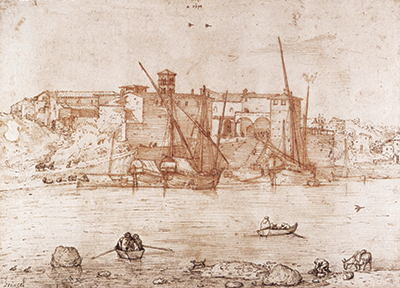This delightful drawing captures a scene in Rome and was produced by Bruegel the Elder using pen and brown ink in around 1552-1553. Most of his drawings were based in Northern Europe, so this offers an alternative landscape inspiration.
Porto di Ripa Grande was formerly the river port of Rome, and here attracted the attention of this Dutch artist who would occasionally travel around Europe in seek of new ideas and influences. He is sat across the river from the city here, close to the shoreline with several small boats making their way across. In the foreground there are other workers and cattle going about their daily lives, though most of the composition is devoted to detailing the more complex city architecture. The river passes through the centre of the scene fairly calmly and is the overall atmosphere is one of peace and relaxation. Bruegel uses different tones for the near and far side, increasing the contrast between the top and bottom of the drawing.
Bruegel was entirely aware of the qualities found in Italian art during this period, and in the years previous. Italy would therefore be the obvious destination for his journeys of discovery and here he would travel around the various cultural cities. Drawing offered an opportunity to sit and work by himself, without having to carry around huge amounts of instruments and tools. He could work quickly and probably found this side of the river to be relatively quiet. The main work in this particular drawing would have been the city's architecture, which stretches right across the sketch, featuring a variety of structures including narrow towers and strong, fortified walls.
The drawing can now be found at Chatsworth House in the UK as part of their permanent collection. They have something called the Devonshire Collections into which all of their items are categorised. There is a diverse selection, going far beyond just art itself, though their collection of old master drawings is particularly interesting. Ceramics, furniture and jewellery are also really well represented here though the highlights from the drawings set includes Leda and the Swan by Leonardo da Vinci, Landscape with Riderless Horse Pursued by a Serpent by Titian, Seated Woman Reading with Child by Raphael and also A Peasant Girl Churning Butter by Peter Paul Rubens.




